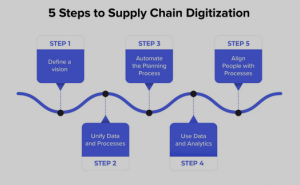Digital technologies have played a transformative role in reshaping global supply chains, making them more efficient, transparent, and responsive. These technologies leverage data, connectivity, and advanced analytics to optimize various aspects of the supply chain process. This study highlights key relationship which digital technologies in transforming global supply chains

Digital Technologies In Transforming Global Supply Chains
Table of Contents
Toggle1. Supply Chain Visibility:
- Real-Time Tracking: Digital technologies enable real-time tracking of goods throughout the supply chain. RFID (Radio-Frequency Identification), GPS, and IoT (Internet of Things) devices provide accurate and up-to-date information on the location and condition of shipments.
2. Data Analytics and Predictive Insights:
- Big Data Analytics: Analyzing large volumes of data allows for better forecasting, demand planning, and risk management. Predictive analytics help anticipate disruptions and optimize inventory levels.
- Machine Learning Algorithms: Machine learning algorithms can analyze historical data to identify patterns and trends, enabling more accurate predictions for demand, lead times, and potential disruptions.
3. Inventory Optimization:
- Demand Sensing: Digital technologies enable demand sensing, allowing organizations to dynamically adjust inventory levels based on real-time market demand signals. This reduces excess inventory and minimizes stockouts.
- Automated Replenishment: Automated systems, often integrated with ERP (Enterprise Resource Planning) software, can trigger replenishment orders when inventory levels fall below predefined thresholds.
4. Blockchain Technology:
- Enhanced Transparency: Blockchain ensures a secure and transparent record of transactions across the supply chain. It is particularly beneficial for traceability in industries like food and pharmaceuticals.
- Reduced Counterfeiting: Blockchain helps in verifying the authenticity of products, reducing the risk of counterfeit goods entering the supply chain.
5. Collaborative Platforms:
- Supply Chain Collaboration: Digital platforms facilitate collaboration among supply chain partners. Cloud-based platforms allow real-time data sharing, fostering better communication and coordination among suppliers, manufacturers, and distributors.
6. E-commerce Integration:
- E-commerce Platforms: Integration with e-commerce platforms allows for seamless order processing, inventory management, and fulfillment. This is essential for businesses engaged in global e-commerce.
- Last-Mile Delivery Optimization: Digital technologies optimize last-mile delivery, improving delivery routes, providing real-time tracking for customers, and enhancing overall customer experience.
7. Automation and Robotics:
- Warehouse Automation: Robotics and automation technologies enhance the efficiency of warehouse operations. Automated picking systems, sorting, and packing processes contribute to faster order fulfillment.
- Autonomous Vehicles: Autonomous vehicles, including drones and self-driving trucks, offer the potential for faster and more cost-effective transportation.
8. 3D Printing (Additive Manufacturing):
- Localized Production: 3D printing allows for localized and on-demand production, reducing the need for extensive global transportation of finished goods.
- Customization: Additive manufacturing enables more customized and personalized products, meeting specific customer demands.
9. Artificial Intelligence (AI) in Logistics:
- Route Optimization: AI algorithms optimize transportation routes, reducing fuel consumption and transportation costs.
- Dynamic Routing: AI-powered systems can dynamically adjust routes based on real-time traffic conditions, weather, and other variables.
10. Digital Twins:
- Digital Replica of Supply Chain: Digital twins create a virtual replica of the entire supply chain, allowing organizations to simulate and optimize operations before implementing changes.
- Scenario Planning: Digital twins enable scenario planning, helping organizations evaluate the impact of various factors on the supply chain’s performance.
11. Sustainable and Green Supply Chains:
- Environmental Monitoring: Digital technologies help monitor and reduce the environmental impact of supply chain operations. This includes tracking carbon emissions, energy usage, and waste reduction.
- Sustainability Reporting: Transparent reporting on sustainability metrics is facilitated by digital tools, responding to the growing demand for eco-friendly and socially responsible supply chains.
Conclusion:
Digital technologies are at the forefront of transforming global supply chains, enhancing efficiency, agility, and sustainability. As technology continues to evolve, businesses that embrace and integrate these digital advancements will be better positioned to navigate the complexities of global supply chain management and gain a competitive edge in the marketplace.
